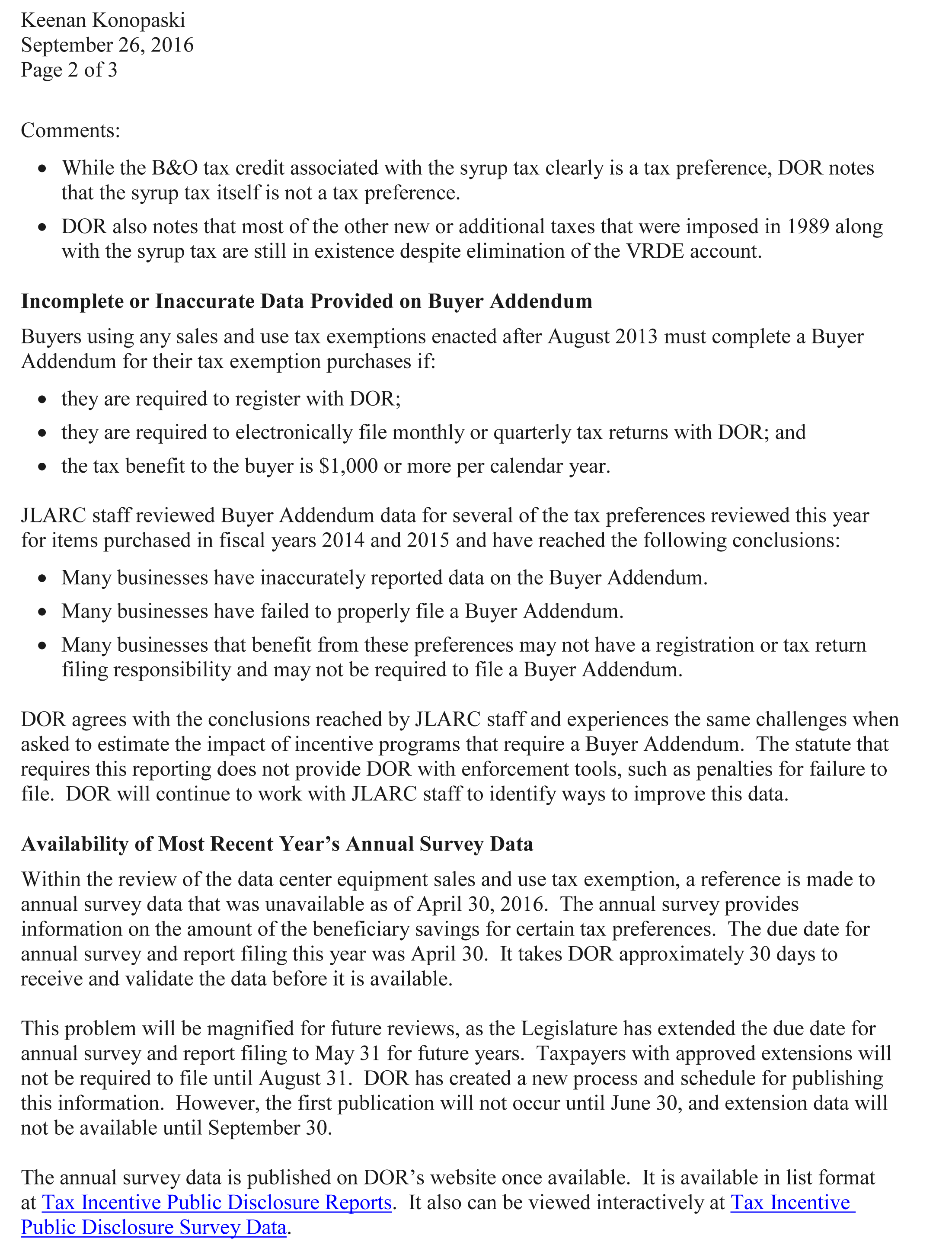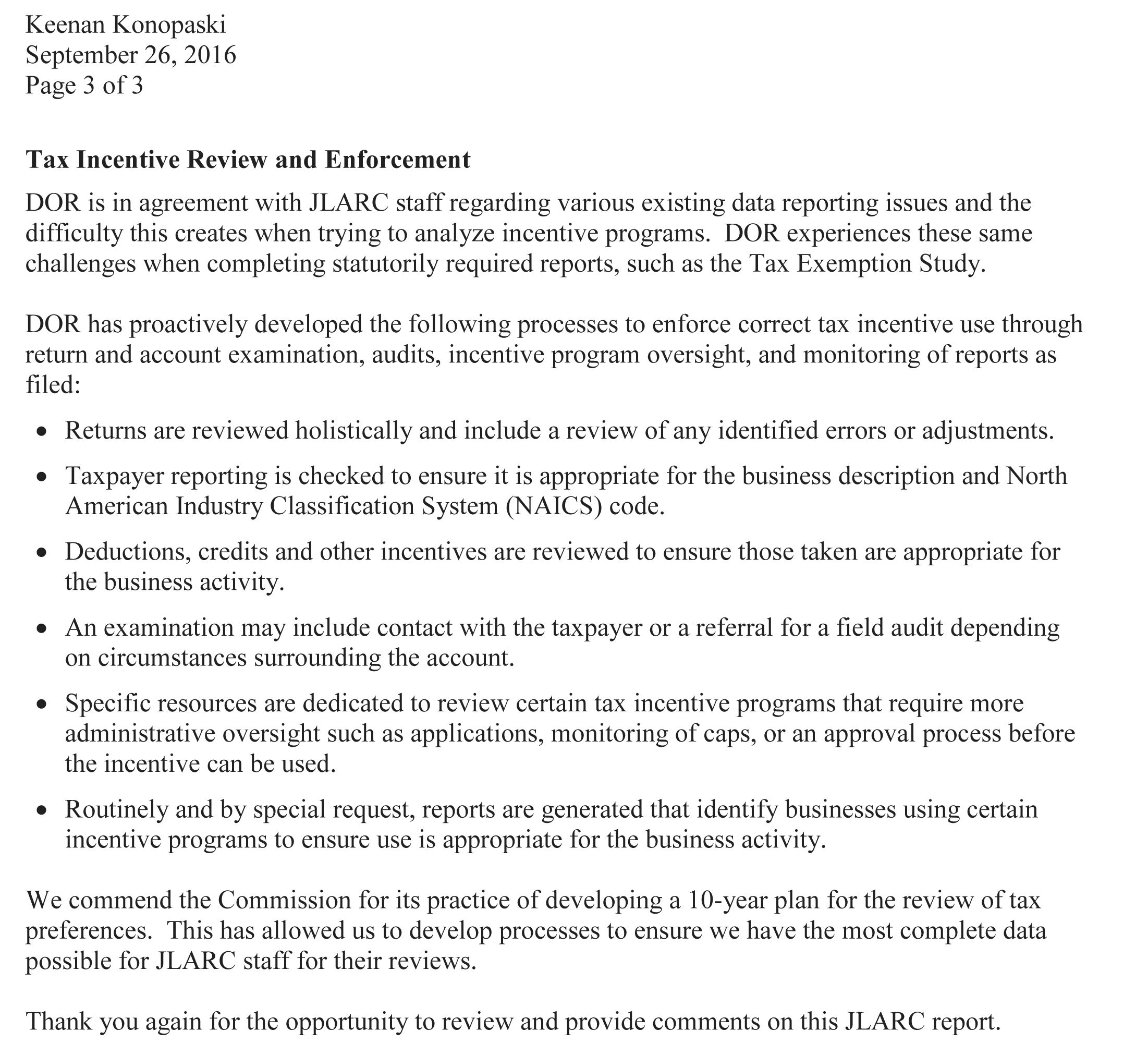JLARC Final Report: 2016 Tax Preference Performance Reviews
Report 17-02, January 2017
Clay Targets | Sales and Use Tax
- Summary of this Review
- Details on this Preference
- Recommendations and Agency Response
- How We Do Reviews
- More about this Review
| The Preference Provides | Tax Type | Estimated Biennial Beneficiary Savings |
|---|---|---|
| A sales and use tax exemption for nonprofit gun clubs on their purchases of clay targets when they are used for target shooting activities and when participants pay to participate.
The preference is scheduled to expire July 1, 2017. |
Sales & Use RCWs 82.08.205; 82.12.205 |
Unknown (Range estimated between $48,000 - $144,000) |
| Public Policy Objective |
|---|
| The Legislature did not state a public policy objective for this preference. JLARC staff infer the objective was to provide tax relief to nonprofit gun clubs on purchases of clay targets used to provide recreational shooting activities to customers or members for a fee. The Legislature made two specific intent statements for this preference:
|
| Recommendations |
|---|
|
Legislative Auditor’s Recommendation
Review and Clarify: While the preference is achieving the inferred objective of providing tax relief to nonprofit gun clubs, it is unclear if the actual fiscal impact reasonably conforms to the 2013 fiscal estimate. Commissioner Recommendation: The Commission endorses the Legislative Auditor’s recommendation. As the Legislature reviews this preference related to the actual fiscal impact, they should also review whether non-profit gun clubs are facing financial distress. If not, the tax preference may no longer be necessary. The rationale for most tax preferences can be linked to clear instances of industry stress, competition, or tax structure issues. No such stresses or issues were identified by the preference or the JLARC staff. |
- What is the Preference?
- Legal History
- Other Relevant Background
- Public Policy Objectives
- Are Objectives Being Met?
- Beneficiaries
- Reporting Issues
- Revenue and Economic Impacts
- Other States with Similar Preference?
- Applicable Statutes
Nonprofit gun clubs do not pay sales or use tax on their purchases of clay targets when
- The targets are used for target shooting at the clubs; and
- Club members and others pay a fee for this activity.
The preference only applies to clay targets purchased by nonprofit gun clubs. Nonprofit gun clubs must be registered as nonprofit corporations with the Secretary of State’s Office, governed by a Board of Directors, and meet other legally mandated criteria.
The preference took effect October 1, 2013, and is scheduled to expire July 1, 2017.
2011 to 2013
The Department of Revenue (DOR) audited several gun clubs that charged for the opportunity to shoot clay targets. In the course of these audits, DOR discovered that some nonprofit gun clubs had not paid sales tax on purchases of clay targets they used to provide target shooting activities to members and others.
DOR’s position was that gun clubs were required to pay sales or use tax on these purchases. DOR’s long-standing interpretation of statute was that businesses must pay sales or use tax on any consumables or supplies used to provide services.
For example, janitorial businesses must pay sales tax on cleaning supplies they consume or use in providing retail cleaning services. It was DOR's position that gun clubs were required to pay tax on the clay targets “consumed” in that activity.
2013
DOR began working directly with legislators and stakeholders to develop a gun club tax guide to educate gun clubs about the taxability of their activities. Representatives of some nonprofit gun clubs asked DOR to delay publishing the gun club tax guide while they sought legislation to exempt clay target sales for nonprofit gun clubs.
Late in the legislative session, the Legislature enacted this tax preference.
Following the enactment of this preference, gun club representatives again asked DOR to withhold publishing the gun club tax guide. As of July 2016, DOR has not published the guide.
Nonprofits Taxed Like For-Profit Gun Clubs, with One Exception
Nonprofit gun clubs provide several different activities to members and others, charge membership fees and dues, charge for the opportunity to shoot, and make retail sales of goods. The following exhibit shows how these various activities are taxed in comparison with for-profit gun clubs.
|
Gun Club Activity |
Activity Subject to Sales Tax? |
|
|
For-Profit
Gun Clubs |
Nonprofit
Gun Clubs |
|
|
Income
from membership fees and dues |
No
|
No
|
|
Sales of goods (e.g., ammunition, clothing) |
Yes |
Yes |
|
Charges to participate in recreational activities (e.g., target shooting) |
Yes |
Yes |
|
Purchases of goods used by club to provide target shooting |
Yes |
No, for clay targets
only. Scheduled to expire July 1,
2017 |
What are the public policy objectives that provide a justification for the tax preference? Is there any documentation on the purpose or intent of the tax preference?
The Legislature did not explicitly state the public policy objective for this preference. JLARC staff infer the objective was to provide tax relief to nonprofit gun clubs on purchases of clay targets used to provide recreational shooting activities to members and others for a fee.
While not identifying a specific public policy objective, the Legislature did make two specific statements about its intent for this preference:
- The Legislature said it intends for this preference to be temporary in order for the Legislature to assess whether the actual fiscal impact of the preference reasonably conforms with the DOR fiscal estimate; and
- The Legislature said it is not its intent to establish a broad policy of providing sales and use tax exemptions for business consumables used by businesses in the provision of services to customers.
The Legislature made these two statements in an intent section rather than in a tax preference performance statement.
What evidence exists to show that the tax preference has contributed to the achievement of any of these public policy objectives?
The tax preference is meeting the inferred objective of providing tax relief to at least some nonprofit gun clubs. Less than a third of nonprofit gun clubs are reporting using the preference. It is not clear whether the actual use of the preference conforms to the fiscal estimate.
The Legislature has been successful in meeting its own objective of not providing broad exemptions for business consumables.
Provide Tax Relief
The Department of Revenue (DOR) estimates there are 36 nonprofit gun clubs in Washington, all of which are eligible to use the preference. From Fiscal Year 2014 through the first six months of Fiscal Year 2016, 11 nonprofit gun clubs reported using this preference. It is possible that more gun clubs are taking the preference but not filling out a Buyer’s Sales and Use Tax Preference Addendum ("Buyer Addendum"). It is also possible that some gun clubs do not use clay targets, but instead use only stationary targets.
Reasonably Conform to 2013 Fiscal Estimate
It is not clear whether the actual fiscal impact of this tax preference conforms to DOR’s 2013 fiscal estimate. With less than a third of eligible gun clubs reporting, the actual use has almost reached the DOR estimate.
Two sources of information should be available to compare actual impacts to the 2013 estimate:
- The businesses selling clay targets to nonprofit gun clubs would report these tax-exempt sales on DOR tax returns; and
- The nonprofit gun clubs buying clay targets would file a Buyer Addendum detailing their tax-exempt purchases.
However, in this case, the number of businesses selling clay targets is too small to allow disclosure, and the Buyer Addendum information from the nonprofit gun clubs appears to be under-reported. (See the tab on Reporting Issues for more detail.)
In addition, the Legislature has not expressly defined what it means by “reasonably conforms.”
The exhibit below provides information about DOR’s 2013 fiscal estimate for the preference. As noted in the section above about providing tax relief, less than a third of nonprofit gun clubs report using the preference. The exhibit shows the amounts these clubs are reporting. The actual amount used by the remaining two-thirds of the nonprofit gun clubs (if they use clay targets) is unknown.
|
Fiscal Year |
DOR’s Fiscal Estimate |
Actual Amount Reported by Less than 1/3 of
Nonprofit Gun Clubs (# out of 36 reporting) |
Actual Amount Used by Remaining 2/3 of
Nonprofit Gun Clubs |
|
2014 |
$14,000 |
$10,300 (9 out of 36 reporting) |
Unknown |
|
2015 |
$22,000 |
$21,000 (11 out of 36 reporting) |
Unknown |
|
2016 |
$12,000
for ½ year |
$11,800 for ½ year (11 out of 36 reporting) |
Unknown |
Source: JLARC staff analysis of fiscal estimate detail for ESSB 5882, 2013; JLARC staff analysis of Department of Revenue Buyer Addendum and tax return deduction data, Oct 2013 – Dec 2015.
Not Establishing a Broad Policy of Exemption for Business Consumables
Accomplishing this objective is up to the Legislature. As of March 2015, the Legislature is accomplishing its intent by not enacting additional sales and use tax preferences for business consumables used by businesses in the provision of services to customers.
To what extent will continuation of the tax preference contribute to these public policy objectives?
Continuing the preference beyond the current July 1, 2017, expiration date would continue to provide tax relief to nonprofit gun clubs. Less than a third of the clubs are reporting using the preference.
It is not clear how continuing the preference would contribute to the Legislature’s stated intent for impacts to conform to the DOR fiscal estimate, since the actual beneficiary savings is unknown.
Who are the entities whose state tax liabilities are directly affected by the tax preference?
Direct Beneficiaries
The direct beneficiaries of the tax preference are nonprofit gun clubs that buy clay targets for people to shoot at their clubs. The Department of Revenue data estimates there are 36 nonprofit gun clubs in Washington, all of which are eligible for the preference. For Fiscal Year 2014 through the first six months of Fiscal Year 2016, 11 clubs reported using this preference. It is unclear why less than a third of the eligible clubs report using the preference. It is possible more clubs are taking the preference but not filing a Buyer Addendum.
Indirect Beneficiaries
To the extent that nonprofit gun clubs pass their tax savings on, indirect beneficiaries are members and customers who shoot clay targets for a fee at the clubs.
Two Reporting Issues
Two reporting issues complicate publishing an estimate of beneficiary savings for this preference:
- Information reported by companies that sell clay targets to the nonprofit gun clubs is not disclosable; and
- Information provided by nonprofit gun clubs using a Buyer Addendum appears to be under-reported.
Information from Businesses Selling Clay Targets Not Disclosable
Fewer than three businesses reported selling tax-exempt clay targets. The Department of Revenue’s (DOR) taxpayer confidentiality policy prohibits disclosure of tax return data if it is comprised of fewer than three taxpayers. JLARC staff contacted the businesses to request specific authorization to disclose the tax return data, but the businesses did not respond. Thus, JLARC staff are prohibited from disclosing actual Fiscal Year 2014 and 2015 tax return information from sellers to estimate beneficiary savings for this preference.
Information Provided by Nonprofit Gun Clubs Appears Under-Reported
Buyers using sales and use tax exemptions enacted after August 2013 must complete a Buyer Addendum detailing their tax-exempt purchases if:
- They are required to register with the Department of Revenue (DOR);
- They are required to file monthly or quarterly tax returns with DOR; and
- The tax benefit to the buyer is $1,000 or more per calendar year.
Of the 36 nonprofit gun clubs that may be eligible to take this preference, less than a third have filed a Buyer Addendum in any fiscal year. From Fiscal Year 2014 through the first six months of Fiscal Year 2016, 11 nonprofit gun clubs reported using this preference. It is not clear why more of the gun clubs did not file a Buyer Addendum. JLARC staff identified two possible explanations:
- The reporting instructions DOR mailed to nonprofit gun clubs in August 2013 did not include instructions directing the gun clubs to complete a Buyer Addendum. DOR added that detail to the reporting instructions in November 2013, over a month after the preference took effect. Some nonprofit gun clubs may be unaware of the requirement to complete the Buyer Addendum.
- Some nonprofit gun clubs are not required to file a Buyer Addendum. For instance, some may save less than $1,000 in a calendar year from the preference.
What are the past and future tax revenue and economic impacts of the tax preference to the taxpayer and to the government if it is continued?
JLARC staff estimate that direct beneficiaries of the preference saved between $21,000 and $63,000 in Fiscal Year 2015, and will save between $48,000 and $144,000 in the 2015-17 Biennium. The precise amount of beneficiary savings for the preference is unknown.
- The lower end of the ranges presented in the exhibit are based on the information provided by the 11 nonprofit gun clubs that filed a Buyer Addendum. This represents less than a third of the nonprofit gun clubs likely eligible to use the preference.
- The upper range of the estimate assumes that another 25 nonprofit gun clubs use the preference at the same level as the 11 clubs that reported.
See the tab on Reporting Issues for more information on the challenges associated with this estimate.
|
Fiscal
Year |
Range
of Estimated Beneficiary Savings |
Actual
Beneficiary Savings |
|
2014 (Oct 1, 2013 – June 30, 2014) |
$10,300
- $31,000 |
Unknown |
|
2015 |
$21,000
- $63,000 |
Unknown |
|
2016 |
$23,500
- $71,000 |
Unknown |
|
2017 |
$24,500
- $73,000 |
Unknown |
|
2015-17
Biennium |
$48,000
- $144,000 |
Unknown |
If the tax preference were to be terminated, what would be the negative effects on the taxpayers who currently benefit from the tax preference and the extent to which the resulting higher taxes would have an effect on employment and the economy?
If the tax preference were terminated, nonprofit gun clubs that provide recreational target shooting services to members and others for a fee would pay sales or use tax on their purchases of clay targets used in providing shooting services. The nonprofit gun clubs could either increase their shooting fees or memberships fees or choose to absorb the additional costs.
Do other states have a similar tax preference and what potential public policy benefits might be gained by incorporating a corresponding provision in Washington?
In states that impose sales tax, JLARC staff identified three states with specific sales tax exemptions for certain gun or shooting clubs activities or purchases:
- Idaho - exempts nonprofit shooting ranges from charging sales tax on customer shooting fees
- Kansas - exempts clay targets purchased by any gun club or shooting range from sales tax
- Wisconsin - exempts admission fees to nonprofit gun clubs from sales tax if the gun club provides safety classes to 25 or more people in a calendar year
In addition, South Carolina imposes a 5 percent special admissions tax on hunting and shooting clubs, but does not charge sales tax on their fees.
Intent Statement
Intent—2013 2nd sp.s. c 13: "The legislature intends for the tax preferences in sections 402 and 403 of this act to be temporary in order for the legislature to assess the actual fiscal impact of the tax preferences to ensure that they reasonably conform with the fiscal estimate provided in the legislation's fiscal note. It is not the legislature's intent to establish a broad policy of providing sales and use tax exemptions for business consumables used by businesses in the provision of services to customers." [2013 2nd sp.s. c 13 § 401.]
RCW 82.08.205
Exemptions—Clay targets. (Expires July 1, 2017.)
(1) The tax levied by RCW 82.08.020 does not apply to sales of clay targets purchased by a nonprofit gun club for use in providing the activity of clay target shooting for a fee.
(2) The exemption is available only when the buyer provides the seller with an exemption certificate in a form and manner prescribed by the department. The seller must retain a copy of the certificate for the seller's files. For sellers who electronically file their taxes, the department must provide a separate tax reporting line for exemption amounts claimed under this section.
(3) This section expires July 1, 2017.
[2013 2nd sp.s. c 13 § 402.]
RCW 82.12.205
Clay targets. (Expires July 1, 2017.)
(1) The provisions of this chapter do not apply with respect to the use by a nonprofit gun club of clay targets that are provided while conducting the activity of clay target shooting for a fee.
(2) This section expires July 1, 2017.
[2013 2nd sp.s. c 13 § 403.]
- Legislative Auditor Recommendation
- Letter from Commission Chair
- Commissioners’ Recommendation
- Agency Response
Legislative Auditor Recommendation
The Legislature should review and clarify the sales and use tax exemption for clay targets for nonprofit gun clubs because while the preference is meeting the inferred objective of providing tax relief to nonprofit gun clubs, it is unclear if the actual fiscal impact reasonably conforms to the 2013 fiscal estimate.
The preference is scheduled to expire on July 1, 2017.
Legislation Required: Yes.
Fiscal Impact: Depends on legislative action.


The Commission endorses the Legislative Auditor’s recommendation.
As the Legislature reviews this preference related to the actual fiscal impact, they should also review whether non-profit gun clubs are facing financial distress. If not, the tax preference may no longer be necessary. The rationale for most tax preferences can be linked to clear instances of industry stress, competition, or tax structure issues. No such stresses or issues were identified by the preference or the JLARC staff.
Joint Department of Revenue and Office of Financial Management Response


